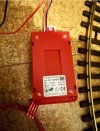flibberflops
Registered
Hi,
Just getting back into LGB since my childhood and I have brought a bit of 2nd hand bits to get started. It is all working, but not very well I thought I would clarify if it is working as expected.
I have a 20761 Engine on a short section off track (Which I have sanded/cleaned) - powered by a simple DC setup... A LGB 198983 Controller powered by a LGB L51090 18v 365w PSU
Everything is working.... but its a bit pants. The controller has speed settings range 0-4, however the engine lights only really illuminates at setting 2 and the engine only starts moving at 2.5. Giving a limited 2.5 - 4 range for actual movement!
When I stick the multimeter on the controller output, it is giving only 6v at speed setting 2 and 16v at setting 4.... Testing the PSU directly shows the full 18v.
I have whipped the bottom plate off the engine and checked the pickups and the wheel bushes... all seem to have loads of life and nothing seems amiss.
Question... Am I supposed to see movement on my engine below 6v? If not, is the LGB Controller supposed to limiting the 0-2 speed settings to under 6v? (basically I am trying to work out if this is just a rubbish controller or if I have a engine issue)
Just getting back into LGB since my childhood and I have brought a bit of 2nd hand bits to get started. It is all working, but not very well I thought I would clarify if it is working as expected.
I have a 20761 Engine on a short section off track (Which I have sanded/cleaned) - powered by a simple DC setup... A LGB 198983 Controller powered by a LGB L51090 18v 365w PSU
Everything is working.... but its a bit pants. The controller has speed settings range 0-4, however the engine lights only really illuminates at setting 2 and the engine only starts moving at 2.5. Giving a limited 2.5 - 4 range for actual movement!
When I stick the multimeter on the controller output, it is giving only 6v at speed setting 2 and 16v at setting 4.... Testing the PSU directly shows the full 18v.
I have whipped the bottom plate off the engine and checked the pickups and the wheel bushes... all seem to have loads of life and nothing seems amiss.
Question... Am I supposed to see movement on my engine below 6v? If not, is the LGB Controller supposed to limiting the 0-2 speed settings to under 6v? (basically I am trying to work out if this is just a rubbish controller or if I have a engine issue)

